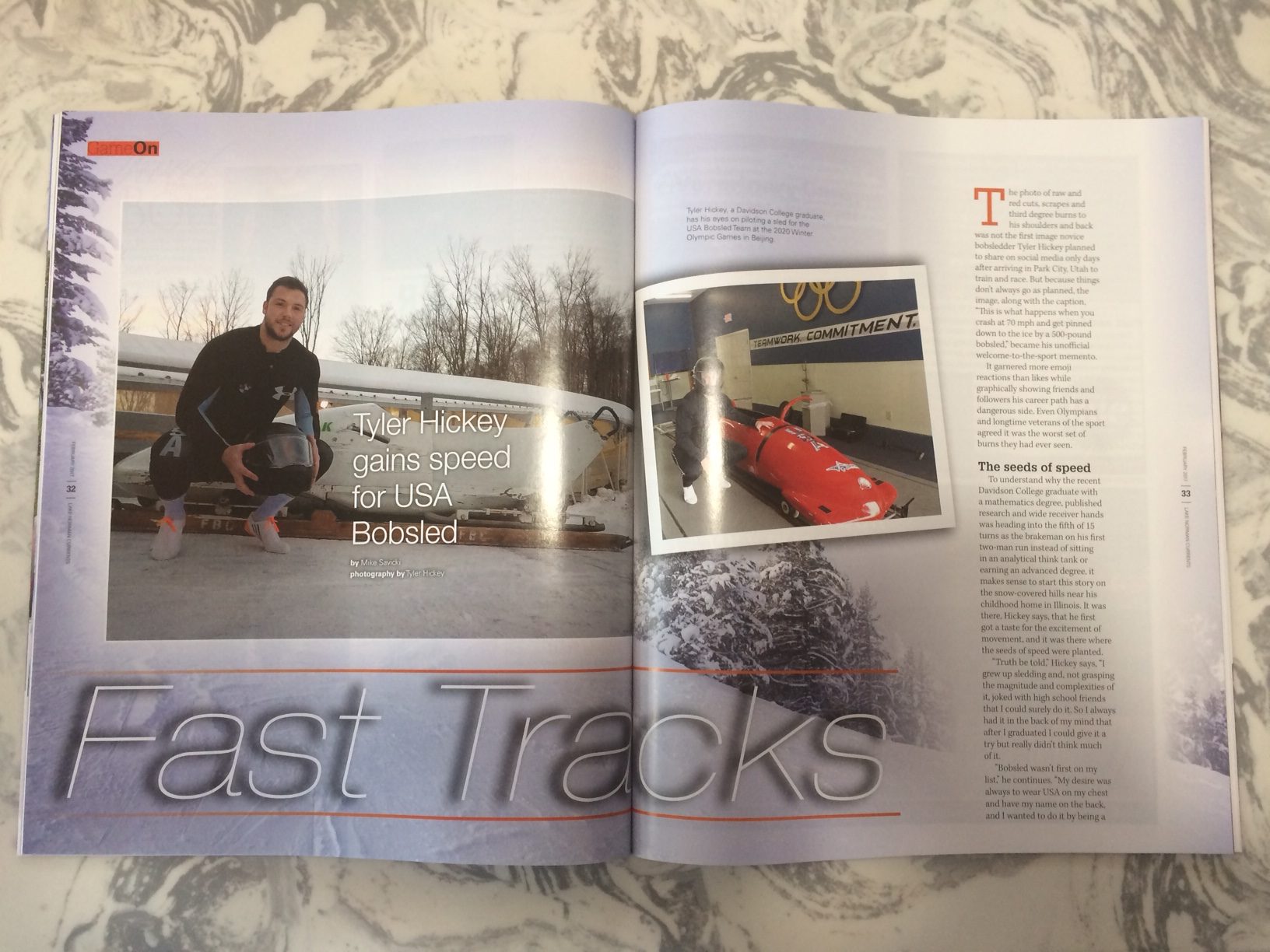Fast Tracks
This article was originally published in the February 2017 edition of Lake Norman Currents magazine.
Tyler Hickey gains speed for USA Bobsled
The photo of raw and red cuts, scrapes and third degree burns to his shoulders and back was not the first image novice bobsledder, Tyler Hickey, had planned to share on social media only days after arriving in Park City, Utah, to train and race. But because things don’t always go as planned, the image, along with the caption, “This is what happens when you crash at 70 mph and get pinned down to the ice by a 500-pound bobsled,” became his unofficial welcome-to-the-sport memento.
It garnered more emoji reactions than likes while graphically showing friends and followers his career path has a dangerous side. Even Olympians and longtime veterans of the sport agreed it was the worst set of burns they had ever seen.
The seeds of speed
To understand why the recent Davidson graduate with a mathematics degree, published research, and wide receiver hands was heading in to the fifth of 15 turns as the brakeman on his first two-man run instead of sitting in an analytical think-tank or earning an advanced degree, it makes sense to start this story on the snow-covered hills near his childhood home in Illinois. It was there, Hickey says, that he first got a taste for the excitement of movement, and it was there where the seeds of speed were planted.
“Truth be told,” Tyler Hickey says, “I grew up sledding and, not grasping the magnitude and complexities of it, joked with high school friends that I could surely do it. So I always had it in the back of my mind that after I graduated I could give it a try, but really didn’t think much of it.
“Bobsled wasn’t first on my list,” he continues. “My desire was always to wear USA on my chest and have my name on the back, and I wanted to do it by being a Navy pilot. I really wanted to serve, so much so that even a few years ago I made calls to a Charlotte Navy recruiter asking if congenital cataracts might be a limiting factor. When I heard his reply, that little voice that kept telling me to try bobsled got louder. I’d still be wearing the stars and stripes on my chest and still representing my country, I told myself. It was something I still knew I could do.”
Fast and furious
Foregoing his senior year as a Wildcat wide receiver, Hickey instead chose to focus his training on preparing for a post-graduation USA Bobsled and Skeleton columbine tryout which he had circled on his calendar. His football training easily transitioned to bobsled-specific sessions at Champion’s Sports Performance in Cornelius, where he also worked as a strength and conditioning trainer. And to keep his football mind sharp, Hickey spent the year completing sport-specific analytical
research with Dr. Timothy Chartier.
Two months after graduating, Tyler Hickey’s life shifted to fast and furious. From a July columbine of 400 invited athletes, he was one of 16 selected to attend a rookie camp in August at the Lake Placid Olympic Training Center. And following that camp, when the list was whittled down to eight, Hickey’s name remained. Merely weeks after the Winer Park Olympic Bobsled track opened, Hickey joined Team USA athletes to begin making training runs on the newly frozen track in preparation for the upcoming season.
Then, the crash. On his first run, Hickey’s sled entered turn five late, never recovered, exited late high up the 15-foot wall then flipped, pinning both he and his teammate underneath while skidding nearly a half mile upside down before coming to rest in the uphill finishing area.
The friction made quick work of his training suit and burn vest.
“Unfortunately it was kind of an old burn vest so it went right through,” he recalls. “While there was enough friction to burn me up, there wasn’t enough to slow the sled down.”
Surgery followed where Tyler Hickey received full and partial skin grafts.
Becoming a pilot
In what might seem like an ironic, yet fortunate twist of fate, shortly before his crash, Hickey was approached by Team USA coaches and asked if he might consider becoming a pilot instead of a brakeman.
“Understanding the mathematics and physics of the sled, being in charge of my own ‘pit crews,’ making sure the runners are down, things are aligned, learning the steering and the courses, then getting behind the rings,” he says, “what an absolute honor.”
On New Year’s Day 2017, Hickey left his Illinois home fully recuperated and rehabilitated to return to Lake Placid for three months of intense training and racing to finish out the season. (He will return to the Lake Norman area in May for off-season training and to work at the Charlotte tech firm Tresata.) After one competition as a brakeman, he will make the full-time transition to pilot, the most complex and physically and mentally demanding position in the sport.
And it is as pilot where he will ultimately bring his mathematical mind and wide receiver hands into the sport, too, learning and mastering the minute physics and performance parameters of preparing then piloting the sled against top international competition. In those contests, races are determined by tenths and hundredths of a second.
His ultimate goal is to pilot a sled for Team USA in the 2020 Beijing Winter Olympic Games.

